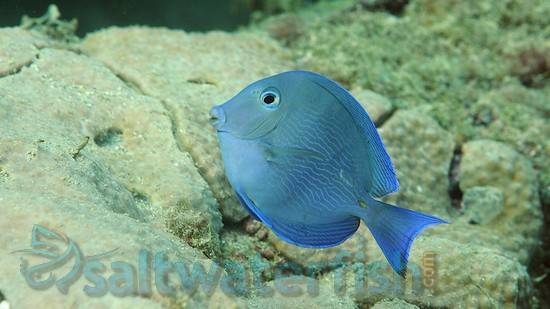Atlantic Blue Tang (Acanthurus coeruleus)
Quick Stats:
- Care Level: Moderate
- Temperament: Peaceful
- Diet: Herbivore
- Reef Safe: Yes
- Minimum Tank Size: 120 gallons
- Max Size: 12 inches
- Water Parameters: pH 8.1-8.4, Salinity 1.020-1.025, Temperature 72-78°F
Comprehensive Guide to Atlantic Blue Tang (Acanthurus coeruleus)
The Atlantic Blue Tang, or Acanthurus coeruleus, is popular in saltwater aquariums. This comprehensive guide will give you all the information you need about caring for this beautiful fish.
Habitat
The Atlantic Blue Tang is native to the Western Atlantic Ocean, specifically the Caribbean Sea. It can be found in coral reefs and rocky areas with plenty of hiding spots. In the wild, they are often seen in small groups or pairs.
Reef Safe
The Atlantic Blue Tang is generally considered reef-safe. However, caution should be exercised when keeping them with delicate corals, as they may nip at their polyps. Providing ample hiding places and ensuring a well-established reef tank before introducing this species is best.
Size
The Atlantic Blue Tang can grow up to 12 inches long, making it a relatively large fish for a home aquarium. It is important to provide a large enough tank to accommodate its size.
Temperament
The Atlantic Blue Tang is known for its peaceful temperament. It gets along well with other fish and is not aggressive towards tankmates. However, it may become territorial if kept in a small tank or with other tang species.
Sexual Dimorphism
No distinct visual differences exist between male and female Atlantic Blue Tangs. They are monomorphic, meaning both sexes look similar.
Lifespan
The average lifespan of an Atlantic Blue Tang in captivity is around 8 to 10 years. With proper care, some individuals have been known to live even longer.
Diet in Aquariums
Atlantic Blue Tangs are herbivores and require a diet rich in algae and plant matter. They should be offered a variety of marine-based seaweed, algae sheets, and high-quality commercial herbivore pellets. Providing a balanced diet to ensure their health and vibrant coloration is significant.
Aquascaping Recommendations
When setting up the aquarium for an Atlantic Blue Tang, it is recommended to provide plenty of hiding spots and open swimming areas. Live rock formations and coral structures can create a naturalistic environment that mimics their natural habitat.
Captive Bred Availability
The Atlantic Blue Tang is not commonly available as a captive-bred species. Most individuals found in the aquarium trade are wild-caught. However, efforts are being made to develop successful breeding programs to reduce the demand for wild-caught specimens.
Compatibility with Tankmates
The Atlantic Blue Tang is generally compatible with various tankmates, including peaceful fish, invertebrates, and corals. However, caution should be exercised when keeping them with aggressive or territorial species. It is always recommended to research and carefully select compatible tankmates.
Here are five specific tankmates that are a good choice for the Atlantic Blue Tang:
- Clownfish (Amphiprion sp.): Clownfish are known for their symbiotic relationship with anemones and can coexist peacefully with the Atlantic Blue Tang.
- Hippo Tang (Paracanthurus hepatus): The Hippo Tang is a similar species and can be a suitable tankmate for the Atlantic Blue Tang, as long as the tank is large enough to accommodate both.
- Firefish (Nemateleotris magnifica): Firefish are peaceful and colorful, making them a great addition to a community tank with an Atlantic Blue Tang.
- Fire Shrimp (Lysmata debelius): Fire Shrimp can help maintain the health of the Atlantic Blue Tang by cleaning parasites off its body.
- Soft Corals (Sarcophyton sp.): Soft corals can provide additional color and texture to the aquarium while coexisting peacefully with the Atlantic Blue Tang.
Other Common Names
The Atlantic Blue Tang is also commonly known as the Blue Tang, Regal Tang, or Blue Surgeonfish.
Why Buy from Reefs4Less.com
Reefs4Less.com is a reputable online retailer specializing in saltwater aquarium supplies. They offer a wide range of high-quality products, including fish, corals, and equipment. Their commitment to customer satisfaction and expertise in the industry makes them a reliable choice for purchasing livestock and supplies for your saltwater aquarium.
Popular Questions and Answers
Q: What is the ideal tank size for an Atlantic Blue Tang?
A: The minimum tank size for an Atlantic Blue Tang is 120 gallons. However, a larger tank is recommended to provide ample swimming space and accommodate their potential size.
Q: Can Atlantic Blue Tangs be kept in a reef tank?
A: Yes, Atlantic Blue Tangs are considered reef-safe. However, caution should be exercised when keeping them with delicate corals, as they may nip at their polyps.
Q: What is the lifespan of an Atlantic Blue Tang?
A: The average lifespan of an Atlantic Blue Tang in captivity is around 8 to 10 years. With proper care, some individuals have been known to live even longer.
Q: How often should I feed my Atlantic Blue Tang?
A: Atlantic Blue Tangs should be fed multiple times a day. Offer a variety of marine-based seaweed, algae sheets, and high-quality commercial herbivore pellets to ensure a balanced diet.
Q: Can Atlantic Blue Tangs be kept with aggressive fish?
A: It is generally not recommended to keep Atlantic Blue Tangs with aggressive or territorial fish. They are peaceful by nature and may become stressed or injured in such an environment.
| Size | 2.25 – 3.5 inches |
|---|


Reviews
There are no reviews yet.